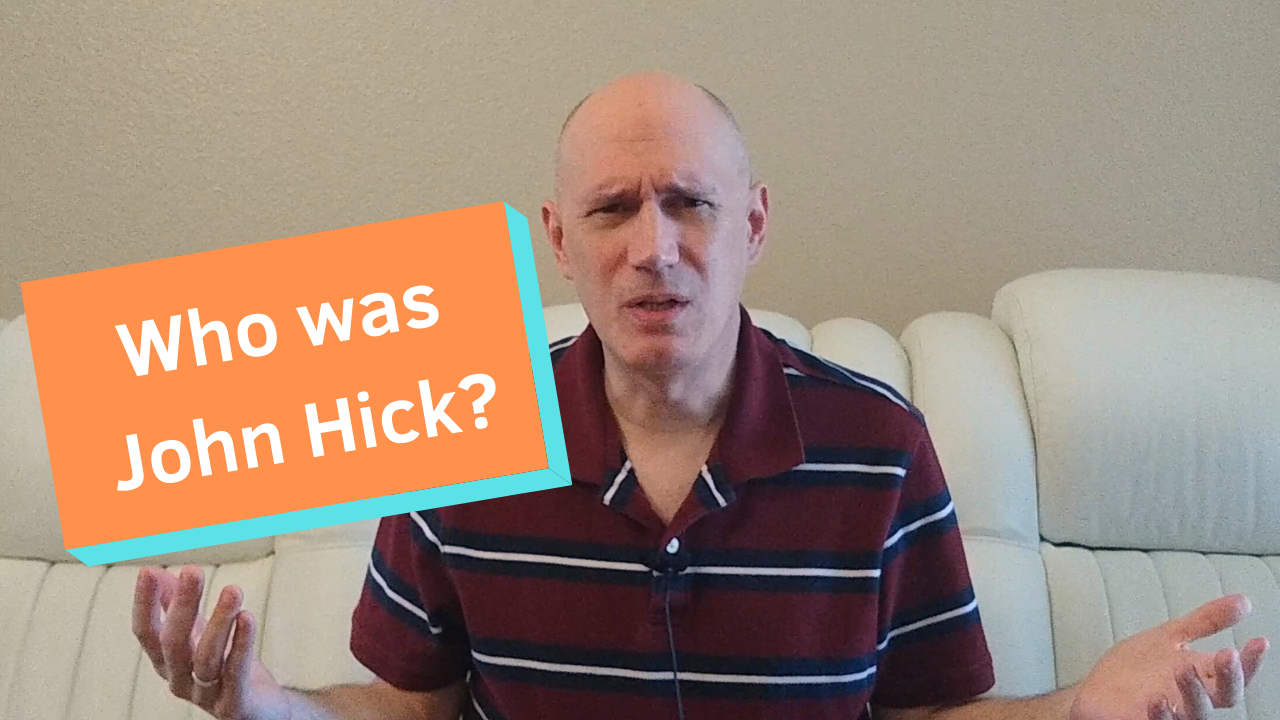06/17/2020 – Who was John Hick?

A Copernican Revolution in religion? What’s that? Stick around and you’ll find out! This is TenOnReligion.
Welcome to TenOnReligion. We’re going to talk about an important philosopher of religion named John Hick today. John Hick was born in 1922 and died in 2012. He was born and raised in England, and taught at many institutions, but mostly at Claremont Graduate University in California and University of Birmingham in England. He has written or edited over 30 books & dozens of articles. The John Hick Centre at the University of Birmingham is named after him.
Now what’s the big deal with John Hick? His two major works that were published in the 1970’s, God and the Universe of Faiths, and The Myth of God Incarnate, were sort of like bombshells in the Christian community. They took a completely different stance against the status quo of some longstanding beliefs in Christian theology which were largely exclusive in nature. Earlier in life, Hick was moved when he met and befriended many people in England from faith backgrounds different from his own. This led to an inquiry on why Christianity was often interpreted exclusively. Let’s get into the details of some of his views.
First, we need to unpack some of the philosophical background for this to all make sense. Hick advocated for a Copernican Revolution in religion referencing the Copernican Revolution in astronomy. This was opposed to the ancient view held for centuries by the Greek mathematician Ptolemy in the mid-100’s. Hick describes that the old Ptolemaic understanding of the universe held that the planets, stars, and even the sun, moved around the earth. After enough observation and much consternation in opposing what was a difficult psychological change for many people, the Copernican revolution happened whereby the sun was shown to be the center of the solar system, largely based first on the Polish astronomer Copernicus’ theory in the 1500’s and later confirmed by Galileo’s observations in the 1600’s in Italy. Hick then asks, what would a Copernican revolution in the theology of religions look like? For Hick, this meant a shift from Christianity (or any religion) being at the center, to God being at the center. Hick was largely concerned about the dominance of Christocentrism in the West and thus advocated for a move towards Theocentrism.
John Hick was a Kantian philosopher meaning his views were rooted in the philosophy of Immanuel Kant, a German philosopher from the late 1700’s. Hick believed God was infinite, which meant the denial of limitation. Kant’s philosophy is extremely complex but to oversimply it, he differentiated between an object as it appears (which he termed the phenomenon) vs. the object in itself (which he termed the noumenon). The object of religion, which Hick used the label “the Real” can be described as the Real-in-itself independent of our experience vs the Real as humanly thought & experienced. There is then this unbridgeable gap between “the Real” and humans’ ability to understand “the Real.” Some people get confused why Hick created this new term “the Real” and his reasoning is simple: he didn’t want to use a word from a particular religion because that might then dominate or overshadow the entire conversation. He wanted to remain as religiously neutral as possible in describing his position. Hick held that there were two main ways of experiencing the Real (sort of like the particle vs. wave theory of understanding light in physics):
- In a personal way – which was basically theistic forms of religious experience, such as YHWH, the Trinity, Allah, Shiva & Vishnu
- In a non-personal way – basically non-theistic forms of religious experience, such as Brahman, Nirvana, & Sunyata
Hick believed that we can never know the Real-in-itself, only as humans experience it in either personal or non-personal forms. What Hick calls the divine noumenon, or the Real-in-itself independent of our experience, is a necessary hypothesis of the pluralistic religious life of humanity. What this means is that since “the Real” is ultimately unknowable in itself, there is obviously going to be more than one way that humans experience it. For Hick, this is the best way to make sense of the plurality of religious experiences of humans. If this were not the case, then one would have to regard all of them as illusory, or return to the confessional position which does not do justice to the evidence (i.e., return to a Ptolemaic understanding of the solar system).
In God and the Universe of Faiths Hick writes, “If I had been born in India I would probably be a Hindu; in Egypt, probably a Muslim; in Ceylon (now Sri Lanka), probably a Buddhist; but I was born in England and am, predictably, a Christian.”
In A Christian Theology of Religions, Hick reiterates a threefold typology originally developed by another scholar named Alan Race in 1983. This threefold typology of religions was exclusivism, inclusivism, and pluralism. Exclusivism is the view that there is only one religious goal and only one way to get to that religious goal, which is through my religion. Basically, it’s my way or the highway sort of view. Inclusivism is a bit more complicated, but basically the inclusivist view is that there is still one religious goal, but more than one way to get there. For example, someone could still get to my ultimate religious goal, but do it through their religion, even if they don’t realize that is what’s happening. This view was popular in Christianity during the Vatican II council meetings in the 1960’s and still has some advocates today. Hick however, does not like either of these options and prefers his option of pluralism as the best answer. Hick’s view of pluralism is that there is one ultimate reality, which again he labels with the religion-neutral term “the Real,” but there is more than way to approach the Real. One image to describe this is the pyramid image, or a mountain in the clouds whereby all of the major world religions are at the bottom and the Real is at the top, but about 2/3 the way up the pyramid, or mountain, there is an obstacle blocking our vision of the top, and that obstacle represents death. One cannot see the ultimate end. So, he suggests, or postulates, that in the end, all religions will ultimately arrive at the same place.
One method he uses to arrive at this conclusion is the soteriological criterion of saintliness. For example, says Hick, take the best person from each religion – the best Jew, the best Hindu, the best Muslim, the best Buddhist, the best Christian and so on. Look at their lives and what do you see? They’re all great people! How can one possibly use this as a criterion to suggest one religion is the right way? So Hick terms salvation/liberation as human transformation, from a problem to a goal. He describes this in general terms as transitioning from Self-centeredness to Reality-centeredness but specifically this means engaging with the Real in a particular religious tradition’s understanding of it.
If his views were adopted, what would change? What is the benefit? Hick suggests that tension between religions would be reduced because the exclusive competition among religions would be eliminated, or at least, greatly dissipated. Hick clearly admits that for many adherents of various religious traditions a huge psychological obstacle will prevent them from accepting such a Copernican revolution. One would need to first reinterpret their religious beliefs from more of a mythological or metaphorical perspective, and the starting place for that is the acceptance of their symbol of the Real as being truly infinite, and if this were the case, they could no longer claim a monopoly on their exclusive interpretation of it.
Some criticisms of John Hick’s view include the idea that Hick assumes or addresses people who are religious. He does not say much about being non-religious, and though he doesn’t quite reject it, he makes a strong effort to demonstrate that religious belief and experiences are rational ways of interpreting reality. He almost seems to be saying that being non-religious is an option, but being religious is a better option, which kind of a tricky position to be in.
Another common criticism focuses on Hick’s postulating that all religions are climbing the same mountain, heading ultimately to the same “Real.” Some have vehemently rejected this idea [buzz] “wrong answer!” all religions are not doing the same thing. They do not have the same goal and have quite different “Reals” they are worshipping. Hick would say such critics are clearly still in exclusivism mode and their response to his views are hardly surprising to him.
What do you think about Hick’s view? Do you like it? Do you think there are better options? Hick’s journey to his theory started in England when he began meeting and becoming friends with people of various religious traditions and these personal encounters started to really change him. One of the best ways to learn about another religion is to find a family or a few friends from a religion different from your own and hang out with them for a year or two. Attend their place of worship, eat meals with their family, observe their religious festivals and so on. You’ll see they might be not all that different from you, and it might just start to change your mind.
Until next time, stay curious. If you enjoyed this vlog, please like this video and subscribe to the channel. This is TenOnReligion.


